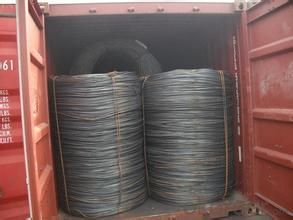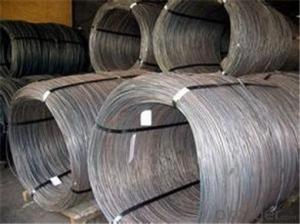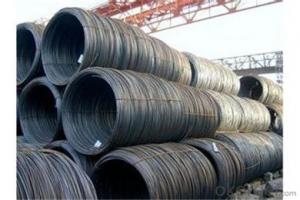SAE1008B Steel Wire rod 5.5mm with Best Quality
- Loading Port:
- Shanghai
- Payment Terms:
- TT OR LC
- Min Order Qty:
- 50 m.t.
- Supply Capability:
- 4000000 m.t./month
OKorder Service Pledge
OKorder Financial Service
You Might Also Like
Item specifice
Description of wire Rod:
wire rod:
Grade:SAE1006B/SAE1008B/SAE1018B
Size:5.5/6.5/7/8/9/10/11/12mm
Festures of wire Rod:
fasteners, bolts, rivets, screws,
general purpose wires,
electrode wires, industrial wires, agriculture wires,
bush wires, chain rivet wires,
detonator wire,
Umbrella ribs, upholstery wires, cycle spokes, needle wires, heald wires, staple pin Wire, safety pin wires
ACSR wires, earth wires,
tyre and hose reinforcement wires,
Specifications of wire Rod:
Grade | Chemical Composition(%) | |||||
C | Mn | Si | S | P | Cr | |
SAE1006B | 0.03~O.07 | ≤0.32 | ≤0.30 | ≤0.045 | ≤0.040 | 0.3-0.35 |
Mechanical properties | ||||||
Yield strength(N/mm2) | Tensile strength(N/mm2) | Elongation(%) | ||||
250-280 | 350-380 | ≥32 | ||||
Grade | Chemical Composition(%) | |||||
C | Mn | Si | S | P | Cr | |
SAE1008B | 0.10max | 0.3~O.50 | 0.15max | 0.050max | 0.040 max | 0.3-0.35 |
Mechanical properties | ||||||
Yield strength(N/mm2) | Tensile strength(N/mm2) | Elongation(%) | ||||
≥195 | 315-430 | ≥30 | ||||
Images of wire Rod:

FAQ:
1. What is your package?
Packing situation: standard seaworthy packing or as customer required.
2. How long is the lead time?
Delivery time: 45 days after order confirmed.
3. What payment term do you accept?
Payment: T/T or L/C at sight.
- Q:What are the different thickness options for steel sheets?
- The thickness options for steel sheets vary depending on the specific application and industry requirements. Common thickness options for steel sheets range from thin gauges, such as 26 gauge (0.0179 inches) or 30 gauge (0.0120 inches), to thicker gauges, such as 16 gauge (0.0598 inches) or 10 gauge (0.1345 inches). However, it is important to note that steel sheets can be customized to meet specific thickness requirements beyond these standard options.
- Q:What are the different sheet metal rolling techniques for steel sheets?
- There are several sheet metal rolling techniques that are commonly used for steel sheets. These techniques include hot rolling, cold rolling, and roll forming. Hot rolling is a process in which steel sheets are heated above their recrystallization temperature and then passed through a series of rollers to reduce their thickness. This technique is commonly used to produce steel sheets with a consistent and uniform thickness. The hot rolling process also improves the mechanical properties of the steel, making it stronger and more ductile. Cold rolling, on the other hand, is a technique in which steel sheets are passed through rollers at room temperature. This process is used to produce thinner and smoother steel sheets with a higher degree of dimensional accuracy. Cold-rolled steel sheets are often used in applications that require a high-quality surface finish, such as automotive body panels and appliances. Roll forming is a continuous bending process in which a long strip of steel is passed through a series of rollers to gradually shape it into a desired profile. This technique is commonly used to produce steel sheets with complex shapes and profiles, such as corrugated roofing sheets or C-channel beams. Roll forming offers excellent precision and repeatability, making it a popular choice for producing large quantities of steel sheets with consistent dimensions. Overall, the choice of sheet metal rolling technique depends on the specific requirements of the application. Hot rolling is ideal for producing steel sheets with a uniform thickness and improved mechanical properties. Cold rolling is preferred for applications that require a high-quality surface finish and dimensional accuracy. Roll forming is suitable for creating steel sheets with complex shapes and profiles.
- Q:What are the different profile options available for steel sheets?
- There are several different profile options available for steel sheets, each serving different purposes and offering unique benefits. Some of the most common profile options include: 1. Plain Sheet: This is the simplest and most basic profile option, with a flat surface and no additional features. It is commonly used for general purposes where aesthetics are not a priority. 2. Corrugated Sheet: Corrugated steel sheets have a series of parallel ridges and grooves, creating a wavy pattern. This profile provides extra strength and rigidity, making it ideal for roofing, cladding, and fencing applications. The ridges also enhance water shedding, preventing water accumulation on the surface. 3. Ribbed Sheet: Ribbed steel sheets have a series of raised parallel ridges or ribs running along the length of the sheet. This profile offers improved strength and load-bearing capacity, making it suitable for applications that require structural integrity, such as mezzanine floors, decking, and industrial flooring. 4. Perforated Sheet: Perforated steel sheets have a pattern of holes punched into them, allowing for ventilation, light transmission, and drainage. This profile is commonly used in architectural designs, façades, acoustics, and filtration systems. 5. Tread Plate: Tread plates have a raised pattern of lines or diamonds embossed on the surface. This profile provides extra grip and slip resistance, making it ideal for industrial flooring, stairs, ramps, and walkways. 6. Expanded Metal: Expanded metal sheets are created by cutting and stretching a flat sheet, resulting in a pattern of diamond-shaped openings. This profile offers excellent ventilation, visibility, and security, making it suitable for applications such as grilles, screens, fences, and enclosures. 7. Lipped Sheet: Lipped steel sheets have an edge or lip bent at a 90-degree angle along one or more sides. This profile provides added strength and stiffness, making it commonly used for framing, shelving, and edge protection. These are just a few examples of the different profile options available for steel sheets. The choice of profile depends on the specific requirements of the application, such as strength, durability, aesthetics, and functionality.
- Q:What are the load-bearing capacities of steel sheets?
- The load-bearing capacities of steel sheets can vary depending on factors such as the thickness, grade of steel, and the specific application. However, steel sheets generally have high load-bearing capacities due to their strength and durability, making them suitable for a wide range of structural and construction purposes.
- Q:Can steel sheets be recycled?
- Yes, steel sheets can be recycled. Steel is one of the most commonly recycled materials worldwide due to its durability and ability to be melted down and reshaped without losing its strength.
- Q:Can the steel sheets be used for roofing purposes?
- Indeed, steel sheets are suitable for roofing applications. Steel roofing sheets are favored because of their long-lasting nature, robustness, and ability to endure severe weather conditions. They offer superb safeguard against elements like rain, snow, and hail. Moreover, steel roofing sheets possess fire-resistant properties and can endure strong winds, rendering them a dependable choice for roofing needs. Furthermore, steel sheets are lightweight, facilitating easier installation and reducing strain on the structure. They come in diverse designs and colors, enabling customization to suit personal preferences. All in all, steel sheets are a versatile and pragmatic option for roofing purposes.
- Q:Are steel sheets suitable for automotive body parts?
- Yes, steel sheets are suitable for automotive body parts. Steel is a commonly used material in the automotive industry due to its strength, durability, and ability to withstand high impact. Steel sheets provide excellent structural integrity and can be easily formed into various shapes to create automotive body panels. Additionally, steel is cost-effective and readily available, making it a preferred choice for manufacturing automotive body parts.
- Q:What is the typical composition of stainless steel sheets?
- Stainless steel sheets are primarily made up of iron, chromium, and nickel. These three elements are the main components that give stainless steel its unique properties. The amount of each element can vary depending on the specific grade of stainless steel being used, but generally, stainless steel sheets contain around 10-30% chromium and 8-20% nickel. Additionally, small amounts of other elements such as carbon, manganese, and molybdenum may be present to further enhance the strength, corrosion resistance, and other desired characteristics of the stainless steel. The composition of stainless steel sheets is carefully balanced to achieve the desired combination of strength, durability, and resistance to corrosion, making it a popular choice for various applications in industries such as construction, automotive, and manufacturing.
- Q:Can steel sheets be used for radiation shielding?
- Yes, steel sheets can be used for radiation shielding. Steel is a dense material that effectively blocks and attenuates various forms of radiation, making it suitable for shielding applications in industries such as nuclear power, healthcare, and aerospace.
- Q:What are the common thicknesses available for steel sheets?
- The common thicknesses available for steel sheets vary depending on the specific application and industry. However, some of the typical thicknesses for steel sheets range from 0.5mm to 25mm, with increments of 0.5mm or 1mm.
1. Manufacturer Overview |
|
|---|---|
| Location | |
| Year Established | |
| Annual Output Value | |
| Main Markets | |
| Company Certifications | |
2. Manufacturer Certificates |
|
|---|---|
| a) Certification Name | |
| Range | |
| Reference | |
| Validity Period | |
3. Manufacturer Capability |
|
|---|---|
| a)Trade Capacity | |
| Nearest Port | |
| Export Percentage | |
| No.of Employees in Trade Department | |
| Language Spoken: | |
| b)Factory Information | |
| Factory Size: | |
| No. of Production Lines | |
| Contract Manufacturing | |
| Product Price Range | |
Send your message to us
SAE1008B Steel Wire rod 5.5mm with Best Quality
- Loading Port:
- Shanghai
- Payment Terms:
- TT OR LC
- Min Order Qty:
- 50 m.t.
- Supply Capability:
- 4000000 m.t./month
OKorder Service Pledge
OKorder Financial Service
Similar products
New products
Hot products
Related keywords






























